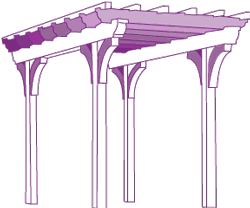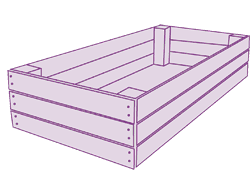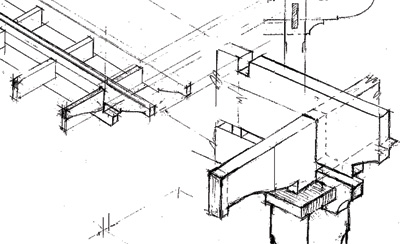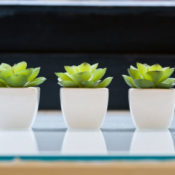Think about “green” building practices and you probably envision such things as high-efficiency windows and lighting, solar panels, or maybe paints and carpeting that leave out the noxious fumes. Those are all correct answers, but only part of the picture.
When it comes to home projects, going green is a broad philosophy that encompasses not only the products you use, but also which projects you choose, the attitude with which you approach them, the people who participate, and even the size and design of your home. That’s the advice from Steve Thomas, host of Planet Green’s Renovation Nation and former longtime host of This Old House on PBS. “You don’t have to put in $40,000 worth of solar panels or drill a geothermal well,” Thomas says. “The accumulation of smaller things — if we all do them — adds up to big numbers.”
Consider one of his recent home projects — adding a pergola to the exterior of a home in Maine. “An outdoor structure like the pergola is not as directly green as water conservation or solar panels,” he acknowledges. “But outdoor structures are a way to increase your space. It gets you outside, and you don’t need as big a house if you use the outside.”
If the house is not as big, that means it doesn’t require as much energy to heat or cool. And if more time is spent in outside spaces, the air conditioner does not need to run as much. “My general philosophy is to keep the space as small as possible and provide transitional space that gets you out of the house and into your yard,” Thomas says.
 The next green consideration in a project like this involves materials. What’s the greenest choice for building a deck or pergola? An obvious pick is Forest Stewardship Council (FSC)-certified lumber. But perhaps the most important factor — even more important than FSC-certified status — is durability and a lack of required maintenance, says Thomas. Materials that don’t last long must be replaced more often — and that means harvesting, shipping, and disposing of more building materials. Better to choose materials that will stand the test of time, such as Western red cedar, which can survive the weather without regular painting or treating.
The next green consideration in a project like this involves materials. What’s the greenest choice for building a deck or pergola? An obvious pick is Forest Stewardship Council (FSC)-certified lumber. But perhaps the most important factor — even more important than FSC-certified status — is durability and a lack of required maintenance, says Thomas. Materials that don’t last long must be replaced more often — and that means harvesting, shipping, and disposing of more building materials. Better to choose materials that will stand the test of time, such as Western red cedar, which can survive the weather without regular painting or treating.
The downside: The most durable materials may cost more at the outset. Consider, however, that their durability pays off in the long-run through lack of required maintenance and a much longer lifespan. That was Thomas’ thinking with his Maine project, which also included a large deck.
“There is nothing that requires maintenance on the outside of the building. It’s not going to self-destruct. It will be resistant to weather and wind,” he says. And applying the less-is-more design philosophy helps with the bottom line, he adds. “If you simplify a project, you can afford to spend more on materials. I kept it simple and dialed up the detailing and materials. Luxury to me is not having a lot to take care of.”
Another important point, says Thomas, is what a home project gives the family — especially the kids or grandkids — in terms of relationships, experiences, and learning opportunities. “For me, the first green principle is to make a connection between the human hand and making things,”
he explains. “I always tried to figure out projects I could do with my son that made the connection between the human hand and stuff. You don’t have to go buy something — you can make it!”

Courtesy: Planet Green/David Johnson
For working with children, Thomas says simple projects are the best — “stuff you can put together relatively quickly and simply. These are life lessons. You plant the seed, and 20 years later, in my own son’s life, I can see trends that were established early on.”
And if those life lessons include an appreciation for things homemade rather than assembled in China, packaged, loaded onto container ships, and sent to the local discount store for impulsive purchases — well, that’s a green lesson. “I would argue that in and of itself is green.”
A great green family project is constructing a raised garden bed and planting it with vegetables. (It’s not hard to do — see the sidebar.) Add another green component by building a garden bench nearby. Kits make the project easy for completion with kids.
And consider installing a rain barrel for watering the garden, Thomas suggests. Kits are available for this project, too, though some people recycle barrels from food or drink manufacturers. Either way, they can be hooked into a downspout and outfitted with a spigot and hose at the bottom. “It’s deeply
satisfying to use water that you have harvested from the sky,” he says. “I like to call it ‘cloud juice.’ ”
Green projects are great, but it’s clear that Thomas sees green building as a way of life, not just the way families fill their time on weekends. “This is not adding onto an existing lifestyle,” he says. “This is going back to — or forward to — a different lifestyle where we recognize that we’re stewards of the planet, not consumers of it.”
Raised Garden Bed: A Green Project for the Family
 Looking for a weekend project that’s good for kids and grandkids, easy to accomplish, and pays lots of dividends? Thomas recommends a raised garden bed. It’s a project that’s green in a number of ways.
Looking for a weekend project that’s good for kids and grandkids, easy to accomplish, and pays lots of dividends? Thomas recommends a raised garden bed. It’s a project that’s green in a number of ways.
It’s a simple project — basically a lumber frame that holds soil deep enough (about 12 to 16 inches) for planting vegetables. Plus, you don’t need very many tools, Thomas points out. “Most of the big home centers will cut lumber to fit. You can load it into your station wagon and bring it home.” Just determine how big you want your raised garden to be and have lumber cut to fit. You can pick something grown to last, such as Western red cedar. Or, if cost is an issue, try a less durable wood.
It will likely hold together for a few years — long enough to provide a lot of enjoyment and bushels full of vegetables.
Assemble the lumber into a sturdy square frame using stainless steel screws or timber screws. Line the bottom with geotextile or landscape fabric, then fill it with fresh loam — a soil comprised of clay and sand containing humus (available at home centers in large bags). “Off you go,” Thomas says, “and you can plant immediately.”
Become a Saturday Evening Post member and enjoy unlimited access. Subscribe now




Comments
The easiest way to garden in a raised bed ever invented get a copy of the, “ALL NEW Square Foot Gardening” book. The method is now used throughout the world including Africa. For more info go to http://www.squarefootgardening.com.
God Bless, Ward.